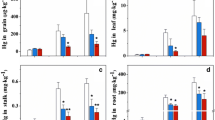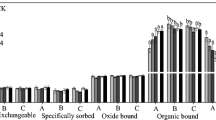Abstract
Purpose
Much attention is directed to the accumulation of mercury and methylmercury (MeHg) in rice grown on Hg-contaminated paddy fields, since they pose a risk to the health of both people and wildlife. Ultimately, measures to control the accumulation of Hg and MeHg in rice should become a key focus of research on this topic. The objective of this study is to test whether Hg and MeHg accumulation are reduced in polished rice when iron and sulfur are added together to the paddy fields during the cultivation of rice.
Materials and methods
In this experimental study, rice plants were grown in pots amended with sulfur and iron. Rice paddy soil contaminated by mercury chloride in the sewage water used for irrigation was simulated in this experiment by Hg-contaminated soil. The total mercury (THg) content added to the soil as mercury chloride reached 120 mg kg−1 as the weight of the dry soil. Two levels of iron (0 and 200 mg kg−1 as FeCl2) as well as sodium sulfate and cysteine (Cys) were added via watering. Two 30-day rice seedlings were transplanted into a root-bag (20 cm long, 12 cm wide), filled with fine quartz sand and cultured in a plastic barrel filled with 4.5 kg of waterlogged soil. When the rice plants matured, samples were taken.
Results and discussion
The addition of iron and sulfur to the Hg-contaminated paddy soil increased the dry weight of rice grains. The THg and MeHg mainly concentrated in the upper soil layer, and the concentrations of MeHg in the treatments with iron and sulfur were especially higher than that of the control. The addition of iron, sulfate and iron, and cysteine and iron decreased THg concentrations in polished rice by 17.7, 38.3, and 21.3%, respectively. The addition of iron, sulfate and iron, or cysteine and iron decreased the MeHg concentration up to 29.9, 36.4, and 48.2% in polished rice, respectively. Thus, we infer that the coupling of sulfur and iron (II) plays an important role in decreasing the accumulation of MeHg in polished rice.
Conclusions
The addition of iron and sulfur together decreased the concentration of THg and MeHg in polished rice. These results can help control concentration levels of MeHg in rice; however, further study of the mechanism of the interaction of sulfur and iron in Hg-contaminated paddy soil should be conducted.




Similar content being viewed by others
References
Abeysinghe K, Ao M, Goodale E, Yang XD, Xu XH, Xu ZD, Qiu GL (2016) Mercury and selenium in arthropods and their bioaccumulation across food webs. Chin J Ecol 35(4):1031–1037 (in Chinese)
Avramescu M, Yumvihoze E, Hintelmann H, Ridal J, Fortin D, Lean DR (2011) Biogeochemical factors influencing net mercury methylation in contaminated freshwater sediments from the St. Lawrence River in Cornwall, Ontario. Canada Sci Total Environ 409(5):968–978
Bonnissel-Gissinger P, Alnot M, Lickes J, Ehrhardt J, Behra P (1999) Modeling the adsorption of mercury(II) on (hydr)oxides II:α-FeOOH (goethite) and amorphous silica. J Colloid Interf Sci 215(2):313–322
Bravo AG, Bouche S, Tolu J. Erik Bjorn E, Alejandro MR, Bertilsson S (2017) Molecular composition of organic matter controls methylmercury formation in boreal lakes. Nat Commun doi: 10.1038/ncomms14255
Chen CC, Dixon JB, Turner TF (1980) Iron coatings on rice roots: mineralogy and quantity influencing factors. Soil Sci Soc Am J 44:635–639
Corrales J, Naja GM, Dziuba C, Rivero RG, Orem W (2011) Sulfate threshold target to control methylmercury levels in wetland ecosystems. Sci Total Environ 409(11):2156–2162
Feyte S, Tessier A, Gobeil C, Cossa D (2010) In situ adsorption of mercury, methylmercury and other elements by iron oxyhydroxides and organic matter in lake sediments. Appl Geochem 25(7):984–995
Frohne T, Rinklebe J, Langer U, Du Laing G, Mothes S, Wennrich R (2012) Biogeochemical factors affecting mercury methylation rate in two contaminated floodplain soils. Biogeosciences 9(1):493–507
Han S, Obraztsova A, Pretto P, Deheyn DD, Gieskes J, Tebo BM (2008) Sulfide and iron control on mercury speciation in anoxic estuarine sediment slurries. Mar Chem 111(3–4):214–220
Hu ZY, Zhu YG, Li M, Zhang LG, Cao ZH, Smith FA (2007) Sulfur (S)-induced enhancement of iron plaque formation in the rhizosphere reduces arsenic accumulation in rice (Oryza sativa L.) seedlings. Environ Pollut 147(2):387–393
Huang TY, Deng H (2016) Effects of reduced nitrogen and phosphorus applications and iron plaque formation on root growth of rice seedlings under mercury stress. Chin J Ecol 9:2417–2421 (in Chinese)
Jay JA, Morel FMM, Hemond HF (2000) Mercury speciation in the presence of polysulfides. Environ Sci Technol 34(11):2196–2200
Jeong HY, Sun K, Hayes KF (2010) Microscopic and spectroscopic characterization of Hg(II) immobilization by Mackinawite (FeS). Environ Sci Technol 44(19):7476–7483
Jonsson S, Skyllberg U, Nilsson MB, Westlund P, Shchukarev A, Lundberg E, Bjoern E (2012) Mercury methylation rates for geochemically relevant Hg-II species in sediments. Environ Sci Technol 46(21):11653–11659
Kaschak E, Knopf B, Petersen JH, Bings NH, König H (2014) Biotic methylation of mercury by intestinal and sulfate-reducing bacteria and their potential role in mercury accumulation in the tissue of the soil-living Eisenia foetida. Soil Biol Biochem 69:202–211
Kim CS, Rytuba JJ, Brown GE (2004) EXAFS study of mercury(II) sorption to Fe- and Al-(hydr)oxides. J Colloid Interf Sci 271(1):1–15
Lehnherr I (2014) Methylmercury biogeochemistry: a review with special reference to Arctic aquatic ecosystems. Environ Rev 22(3):229–243
Li WC, Ouyang Y, Ye ZH (2014) Accumulation of mercury and cadmium in rice from paddy soil near a mercury mine. Environ Toxicol Chem 33(11):2438–2447
Li YY, Zhao JT, Zhang BW, Liu YJ, Xu XH, Li YF, Li B, Gao YX, Chai ZF (2016) The influence of iron plaque on the absorption, translocation and transformation of mercury in rice (Oryza sativa L.) seedlings exposed to different mercury species. Plant Soil 398(1–2):87–97
Liu H, Ma W, Dai JL (2015) Research progress of mercury pollution on rice. J Shan Dong Jian Zhu University 30:170–176 (in Chinese)
Liu JG, Valsaraj KT, Delaune RD (2009) Inhibition of mercury methylation by iron sulfides in an anoxic sediment. Environ Eng Sci 26(4):833–842
Liu YR, Zheng YM, Zhang LM, He JZ (2014) Linkage between community diversity of sulfate-reducing microorganisms and methylmercury concentration in paddy soil. Environ Sci Pollut Res 21(2):1339–1348
Meng B, Feng XB, Qiu GL, Cai Y, Wang DY, Li P, Shang LH, Sommar J (2010) Distribution patterns of inorganic mercury and methylmercury in tissues of rice (Oryza sativa L.) plants and possible bioaccumulation pathways. J Agr Food Chem 58(8):4951–4958
Meng M, Li B, Shao JJ, Wang T, He B, Shi JB, Ye ZH, Jiang GB (2014) Accumulation of total mercury and methylmercury in rice plants collected from different mining areas in China. Environ Pollut 184:179–186
Peng XY, Liu FJ, Wang WX, Ye ZH (2012) Reducing total mercury and methylmercury accumulation in rice grains through water management and deliberate selection of rice cultivars. Environ Pollut 162:202–208
Rothenberg SE, Anders M, Ajami NJ, Petrosino JF, Balogh E (2016) Water management impacts rice methylmercury and the soil microbiome. Sci Total Environ 572:608–617
Rothenberg SE, Feng X, Zhou WJ, Tu M, Jin BM, You JM (2012) Environment and genotype controls on mercury accumulation in rice (Oryza sativa L.) cultivated along a contamination gradient in Guizhou, China. Sci Total Environ 426:272–280
Schaefer JK, More FMM (2009) High methylation rates of mercury bound to cysteine by Geobacter sulfurreducens. Nat Geosci 2:123–126
Shu R, Wang YJ, Zhong H (2016) Biochar amendment reduced methylmercury accumulation in rice plants. J Hazard Mater 313:1–8
Skyllberg U, Drott A (2010) Competition between disordered iron sulfide and natural organic matter associated thiols for mercury(II)—an EXAFS study. Environ Sci Technol 44(4):1254–1259
Slowey AJ, Brown GE (2007) Transformations of mercury, iron, and sulfur during the reductive dissolution of iron oxyhydroxide by sulfide. Geochim Cosmochim Ac 71(4):877–894
Su YB, Chang WC, Hsi HC, Lin CC (2016) Investigation of biogeochemical controls on the formation, uptake and accumulation of methylmercury in rice paddies in the vicinity of a coal-fired power plant and a municipal solid waste incinerator in Taiwan. Chemosphere 154:375–384
Szakova J, Buresova A, Praus L, Garcia-Sanchez M, Holeckova Z, Gabriel J, Sysalova J, Cervenka R, Komarek J, Grohova S, Tlustos P (2016) The response of mercury (Hg) transformation in soil to sulfur compounds and sulfur-rich biowaste application. Environ Earth Sci 75(5847)
Tang WL, Dang F, Evans D, Zhong H, Xiao L (2017) Understanding reduced inorganic mercury accumulation in rice following selenium application: selenium application routes, speciation and doses. Chemosphere 169:369–376
Ullrich SM, Tanton TW, Abdrashitova SA (2001) Mercury in the aquatic environment: a review of factors affecting methylation. Crit Rev Environ Sci Technol 31(3):241–293
Ulrich PD, Sedlak DL (2010) Impact of iron amendment on net methylmercury export from tidal wetland microcosms. Environ Sci Technol 44(19):7659–7665
Wang X, Tam NFY, Fu S, Ametkhan A, Ouyang Y, Ye ZH (2014) Selenium addition alters mercury uptake, bioavailability in the rhizosphere and root anatomy of rice (Oryza sativa). Ann Bot-London 114(2):271–278
Wang YJ, Dang F, Zhao JT, Zhong H (2016a) Selenium inhibits sulfate-mediated methylmercury production in rice paddy soil. Environ Pollut 213:232–239
Wang YJ, Wei ZB, Zeng QL, Zhong H (2016b) Amendment of sulfate with Se into soils further reduces methylmercury accumulation in rice. J Soils Sediments 16(12):2720–2727
Weber JH (1993) Review of possible paths for abiotic methylation of mercury in the aquatic environment. Chemosphere 26(11):2063–2077
Wiatrowski HA, Das S, Kukkadapu R, Ilton ES, Barkay T, Yee N (2009) Reduction of Hg(II) to Hg (0) by magnetite. Environ Sci Technol 43(14):5307–5313
Xing CH, Cai MZ, Liu P, Xu GD (2006) The role of iron and manganese plaques on wetland plant roots in environment and ecology. Ecol Environ 15(6):1380–1384 (in Chinese)
Yu R, Flanders JR, Mack EE, Turner R, Mirza MB, Barkay T (2012) Contribution of coexisting sulfate and iron reducing bacteria to methylmercury production in freshwater river sediments. Environ Sci Technol 46(5):2684–2691
Acknowledgements
This work was financially supported by the National Natural Science Foundation of China (No. 41273152), Hunan Province Natural Science Foundation (No. 14JJ2121), and Opening Fund of the State Key Laboratory of Environmental Geochemistry (grant no. SKLEG2017907, SKLEG2017912).
Author information
Authors and Affiliations
Corresponding author
Additional information
Responsible editor: Dong-Mei Zhou
Rights and permissions
About this article
Cite this article
Zhong, S., Qiu, G., Feng, X. et al. Sulfur and iron influence the transformation and accumulation of mercury and methylmercury in the soil-rice system. J Soils Sediments 18, 578–585 (2018). https://doi.org/10.1007/s11368-017-1786-1
Received:
Accepted:
Published:
Issue Date:
DOI: https://doi.org/10.1007/s11368-017-1786-1




